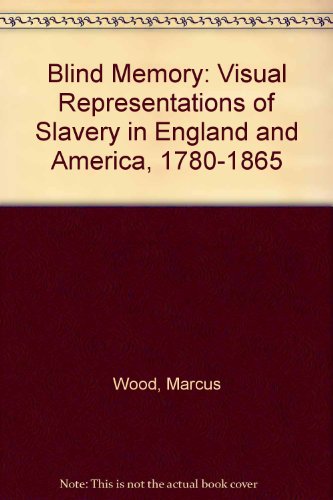Blind Memory: Visual Representations of Slavery in England and America, 1780-1865 - Hardcover

A study of Atlantic slavery generated by the visual arts. It considers in detail four "sites" which have generated particularly influential imagery: the middle passage; flight/escape; slave torture/punishment; and the popular imagery which evolved around Stowe's classic abolition text, "Uncle Tom's Cabin". Abolition exploded in the 1780s as an international propaganda movement. From then on until the end of the Civil War the slavery debate generated a deluge of materials. Every conceivable visual resource was drawn upon, including paintings, sculptures, prints, textiles, maps, ceramics, jewellery, needlework, "tableaux vivantes", and theatrical performance. Different forms require different ways of reading and this text is, of necessity, theoretically experimental and essentially interdisciplinary. Developments in trauma theory, Holocaust studies, Diaspora studies, even cartography, are drawn upon. The book thinks about how the West has remembered slavery through its visual art, but beyond this it demands that we reconsider how slavery is culturally constructed in the West now. The study consequently ends by asking what institutions, rituals, narratives and images we have decided are the "right" way of remembering slavery.
"synopsis" may belong to another edition of this title.
About the Author:
Marcus Wood is Senior Lecturer in the Department of English and American Studies at the University of Sussex. His previous works include Radical Satire and Print Culture 1790-1820.
From Library Journal:
This is an erudite yet remarkably engaging examination of the visual representation of slavery in Europe and North America in the late 18th and early 19th centuries. Wood (English, Sussex Univ., UK) includes a variety of materials, ranging from sophisticated oil paintings to crude woodcuts, based on their influence, popularity, and longevity. Many of the illustrations will be familiar, but Wood does not assume that they speak for themselves and examines them in a new light. He addresses the semiotic codes used to represent slavery and explains how they came to symbolize cultural memory. This study focuses on four areas: the middle passage, the iconography of slave escape, Uncle Tom's Cabin, and the torture and punishment of slaves. It does not include images of slave rebellion, day-to-day slave life, the slave trade itself, or emancipation. The images are both compelling and repulsive in their exploration of how memory is organized and visually depicted. An excellent bibliography further enhances this groundbreaking work. Very highly recommended for academic collections.DDaniel Liestman, Kansas State Univ. Lib., Manhattan
Copyright 2000 Reed Business Information, Inc.
Copyright 2000 Reed Business Information, Inc.
"About this title" may belong to another edition of this title.
- PublisherManchester Univ Pr
- Publication date2000
- ISBN 10 0719054451
- ISBN 13 9780719054457
- BindingHardcover
- Rating
(No Available Copies)
Search Books: Create a WantIf you know the book but cannot find it on AbeBooks, we can automatically search for it on your behalf as new inventory is added. If it is added to AbeBooks by one of our member booksellers, we will notify you!
Create a Want
